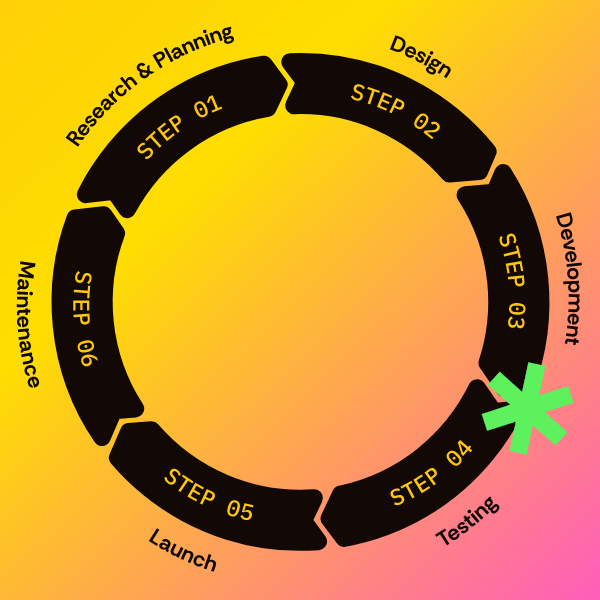What’s missing from the infographic to the right? Whether it shows four stages, nine, or something in between, almost all diagrams illustrating the redesign project process overlook one crucial step: Website production!
Production can make or break your project because it’s how all the pieces come together. Think of it like baking a cake. You’ll need a recipe (planning), ingredients (content, design), and oven (development). But those elements won’t create a cake without mixing (production).
After completing a redesign project’s planning, writing, designing, and coding, it’s time to start website production. This phase—sometimes called implementation—is when all those parts merge into your beautiful, new website.
The work required to build out your new site is a time-consuming, collaborative, and crucial part of the website process. If this work isn’t appropriately planned or treated as an afterthought, it could halt your project right before its launch.
Read on for tips to help you avoid common website production pitfalls during other stages of a site redesign to ensure your project stays on track.
10 questions to answer for a more streamlined website production process
Complex website redesign projects have many different stages. You can minimize the potential issues you might face during production on your new site by getting answers to these key questions before that work begins.
Who’s in charge?
Production involves a coordinated effort across multiple roles. The process can become chaotic and inefficient without a clear project lead and defined responsibilities. Establish a project lead early to delegate tasks, keep the timeline on track, and make decisions when questions arise.
This project lead should develop a detailed production schedule, clearly assigning ownership for each task to specific team members. Incorporating regular internal check-ins allows for questions, status updates, and proactive problem-solving, ensuring everyone understands their responsibilities and the overall project trajectory.
Establishing clear roles and a defined workflow sets the stage for a smooth and organized website production process.
How much time?
A rushed production phase often leads to errors and a subpar final product. Conversely, an overly drawn-out process frustrates stakeholders and delays launch. The key is establishing a realistic timeline with enough resources and staffing to stay efficient without sacrificing quality.
Prioritize communication and optimization throughout the workflow to ensure the project’s website production moves smoothly without getting bogged down by last-minute changes or unclear directives.
Are designs finalized?
It’s tempting to dive into production before content and designs are fully approved to save time. Don’t fall into this trap! Rushing ahead often results in rework, adding time and costs to the project.
Ensure that stakeholders fully approve all content and designs before production begins. This way, you avoid costly revisions and keep the project moving smoothly.
How will you manage website production tasks?
Even with a plan, production is a dynamic phase where feedback and changes happen frequently. As stakeholders provide input on visuals and content, developers refine functionality, and designers make adjustments based on the evolving website, it’s vital to establish clear channels for keeping the production team informed of all changes and decisions. A lack of consistent communication can lead to misunderstandings, misaligned efforts, and unnecessary delays.
To foster effective collaboration, implement clear communication protocols. This could involve utilizing a shared, live document for real-time updates, a dedicated communication platform for quick questions and discussions, or regular team sync-ups.
Ensure these channels allow for easy information sharing, visuals, and feedback. This lets the production team stay aligned with the latest project developments and keep the website build moving forward seamlessly.
Who has the final say?
Once in a rhythm for production, it’s easiest to finish the work all at once, right? This can be a common pitfall as well. Proceeding with the entire website build without pausing to review and approve sample page types can result in significant rework if the initial direction is incorrect. That’s why it’s essential to establish who has the final say and to set up an approval process for sample pages with those stakeholders, especially when creating key templates or page types.
Getting early feedback from decision-makers before scaling the remaining work helps ensure alignment and prevents large-scale revisions later.
Where are the final assets?
Disorganized content is one of the most common production bottlenecks. Establish a structured system to store, track, and update assets, clearly labeling approved versions and archiving older ones.
Use shared, live documents and clearly defined file structures to make it easy for team members to find the latest materials. This prevents confusion and keeps the production phase running smoothly.
What kind of website production training is required?
Is your team working on a new CMS platform that they are unfamiliar with? Trying to learn a new content management system while simultaneously populating the website can slow progress and increase the risk of mistakes. Before starting content implementation, confirm each production team member is adequately trained and comfortable with the website’s CMS to keep the workflow smooth and efficient.
Are all content elements correct?
Quality assurance (QA) is crucial throughout the life of a website, not just during the production of a redesigned site. While content should be QA-ed, cleaned up, and approved before production, every team member should be vigilant in identifying potential errors, from ideation to implementation. This proactive approach prevents oversights that can lead to the launch of an unprofessional site that hurts brand credibility and conversions.
During production, meticulous attention to detail is essential to ensure adherence to standards and formatting and the inclusion of the latest, finalized content on every page. Implementing comprehensive QA checks at each production stage will verify content accuracy, link functionality, and consistent styling, preventing significant issues from snowballing.
What are the content presentation guidelines?
A part of quality assurance is establishing a standard set of content rules. Even something as simple as inconsistent abbreviation styles or headshot sizes can make a website look unprofessional.
As content and designs are being created, develop a comprehensive style guide for all aspects of the website, either starting from a template to help streamline the process or noting down rules as the project progresses. Utilizing this list can be a checklist for your quality assurance process and ensure a unified and polished brand presentation.
What have you done to confirm you’re launch-ready?
Once production is complete, are you finally ready to launch? Are you sure? If testing wasn’t part of your production process, how are you sure? Testing is a part of the website production process that is easy to skip when the excitement to go live is mounting, but neglecting to do this work can backfire.
While your website does not need to be perfect before launch, launching a website without thorough testing can result in a poor user experience and ruin valuable first impressions.
Avoid this by incorporating testing as an essential part of your production process, identifying and resolving issues pre-launch. Conduct testing with fresh eyes—team members who haven’t been deeply involved in the project can often spot mistakes that others miss.
The power of website production
While the initial stages of website design and development often capture the spotlight, production is crucial. It can make your vision come to life or make your new site fall apart.
By proactively addressing the potential dangers of a disorganized process, prioritizing clear communication and collaboration, managing content effectively, and ensuring rigorous quality assurance, you can transform a potentially chaotic experience into a smooth and successful website launch.
Enlist the website redesign experts
With over 20 years of experience bringing websites from conception to launch, TBH Creative’s team understands the critical importance of a streamlined production process. We’ve honed our workflows and established clear protocols to ensure that every detail is handled precisely, resulting in a polished, functional website that reaches goals and exceeds expectations.
Ready to eliminate chaos from your next website project? Contact us today to see how our website production expertise can make all the difference.

